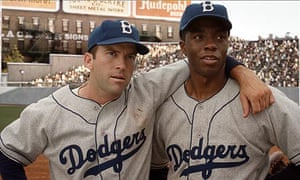42 is an American biographical sports film, directed and written by Brian Helgeland, based on the Brooklyn Dodgers baseball player Jackie Robinson. If you don’t recognize the name Jackie Robinson, then you’re missing out on a revolutionary chunk of history.
Jackie Robinson, played by Chadwick Boseman in the 2013 film, was an American professional baseball player. In fact, he was the first African American to ever play in the major leagues. He started at first base for the Brooklyn Dodgers in 1947. Below is a picture of the scene where Robinson signed with the Brooklyn Dodgers.

42 gives us a dramatized glimpse of Robinson’s journey rising to the MLB, being given a chance to play in the historically all-white league by Brooklyn Dodger owner Branch Rickey, played by Harrison Ford. The film gives us a tear-jerking view of how segregated America was in terms of race in 1947. You see Robinson in constant tension and frustration in regards to brutal racism with the fans he plays in front of, the opponents he plays against, and even some of his own teammates. You see at the end of the film he is able to assimilate in this new world more as his teammates begin to accept him as apart of the team.
The film is a good representation of Hegel’s concept on the One and the Other, but at the same times it’s a good depiction of Bhabha’s idea of hybridity and the Third Space. You can see with each opposition Robinson encounters, they are trying to dominate themselves and have Robinson acknowledge the power they have over him.
Though other characters are a great example of Bhabha’s preferred concept of hybridity, such as Harold Peter Henry “Pee Wee” Reese, played by Lucas Black, who stands up for Robinson as he comes to realize the struggle he faces everyday, and Branch Rickey, who gives Robinson the time of day after he chose against the opportunity to do the same for a black player while he was in college. These two characters are some of the only people different from Robinson who put aside their rigid traditions of being segregated from black people and allowed themselves to accept their cultural differences.
The picture below is from the scene in the film where Pee Wee stands up for Robinson on the field.

